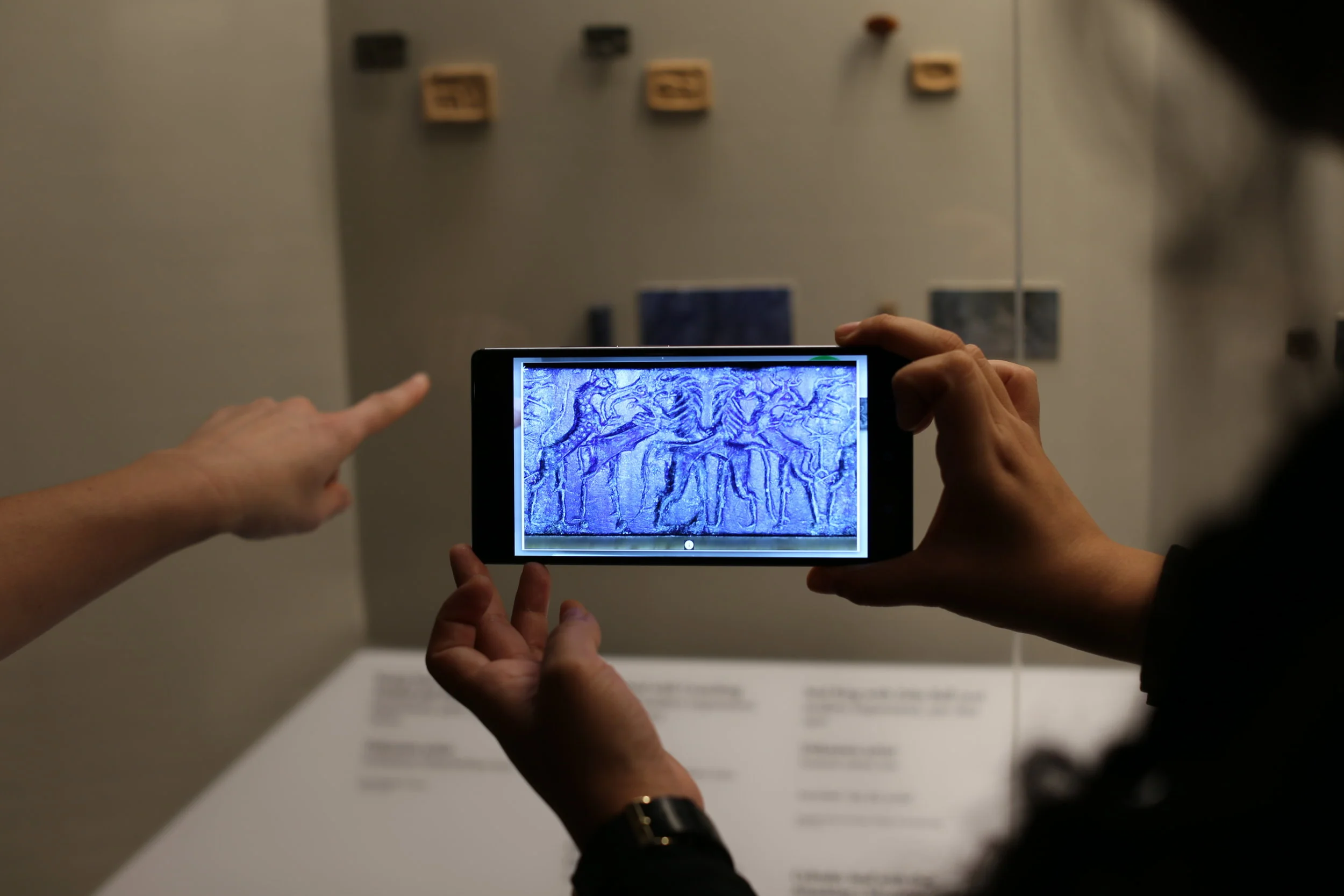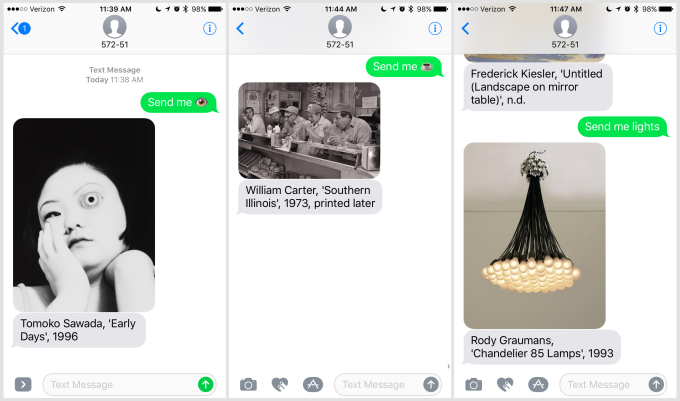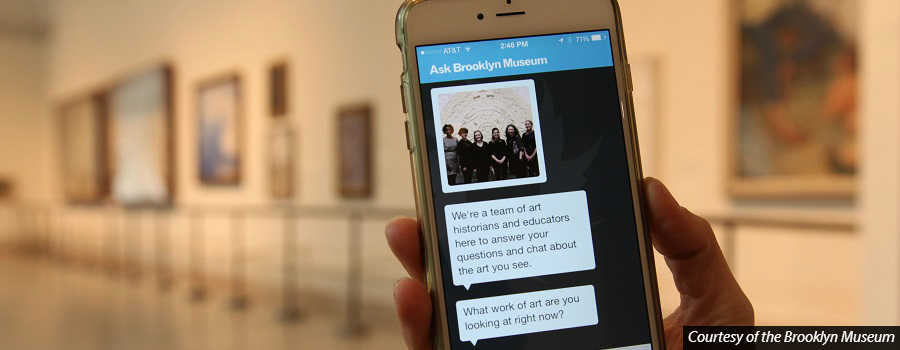Image: chart detailing which cultural institutions respondents are interested in having digital experiences. Source: LaPlaca Cohen, Culture Track ‘17, 2017.
With the rise of the Internet and mobile technologies, museums around the world are being confronted with the changing expectations and needs of audiences living in an increasingly digital landscape. Today’s audiences are increasingly seeking out and demanding personalized, immersive, and shareable experiences. According to research from the 2017 LaPlaca Cohen Culture Track study, audiences across all age groups are most motivated by “having fun” and “experiencing new things.” When asked about where they would be most interested in having digital experiences, respondents ranked museums above all other cultural activities. As the study put it: “For today’s audiences, the definition of culture has democratized, nearly to the point of extinction. It’s no longer about high versus low or culture versus entertainment; it’s about relevance or irrelevance.”[1]
This shift in audience expectations and motivations has led many museums to explore the potential of digital, interactive tools to enable visitor engagement with the institution and its collections. A 2016 study by Axiell in partnership with Museums and the Web found that more than half of museums around the world are currently investing in digital engagement strategies, with 33% of respondents citing that they had mobile apps and guides available for visitors and nearly 40% planning to increase their investment in mobile technology. From in-gallery apps to virtual reality exhibitions, the critical and financial successes of recent models such as the Cleveland Museum of Art’s ArtLens project, the Renwick Gallery’s blockbuster Wonder exhibition and the Cooper Hewitt Pen all illustrate a growing trend towards interactive, immersive technologies as a way to capture visitor attention and remain relevant in the digital age.
As previous AMT Lab articles have demonstrated, the question facing museum managers is no longer whether technology belongs in the museum, but how digital tools can be best leveraged to engage audiences and enhance learning. However, given the high cost of investment and infrastructural change that is typically required for successful digital engagement tools, museum staff must first ask themselves why their institution should consider investing in emerging technologies and what they hope to achieve from such an investment. With a focus on audience engagement goals, this report outlines some of the common factors driving museums to integrate technology with the visitor experience.
1. Engage diverse, tech-savvy audiences
Guests using the Lumin tool at the Detroit Institute of Art. Source: Detroit Institute of Art https://www.dia.org/lumin
Despite encouraging gains in adult attendance at art museums in recent years according to a 2018 NEA report on arts attendance, audiences in the 18-34 age range--commonly referred to as millennials--still have proportionally lower visitation levels compared to other demographic cohorts. And yet, data shows that millennials are in fact the most frequent visitor at cultural organizations, with growth in attendance each year.[2] This conundrum--what audience engagement analyst Colleen Dilenschneider refers to as the “millennial opportunity”--is due to the fact that millennials, being the largest and most diverse generation in American history, are rapidly becoming the primary audience demographic for museums and other cultural institutions. Now more than ever, museums need to find ways to engage with the millennial cohort to ensure long-term relevance and sustainability.
As digital natives raised with the emergence of the Internet and mobile technology, millennials are comfortable with digital tools and particularly responsive to immersive and entertaining experiences.[3] For a constituency accustomed to accessing knowledge in seconds through their phones, the passive, didactic approach of most museum tours holds little appeal. Instead, several museums have explored the potential for digital tools such as mobile apps to create interactive, participatory tours. An exciting example is the Detroit Institute of Arts’ mobile tour guide, Lumin, a handheld tour guide that integrates augmented reality and three-dimensional mapping to allow visitors to experience AR overlays, 3D animations, videos and sounds as they tour the collection. Other museums have had success with social experiences that connect millennials to the museum through social media, like using Facebook Live to bring together Van Gogh paintings from around the world.
2. Increase accessibility and inclusion for the larger population
3D printed version of Andy Warhol paintings are available at the Andy Warhol Museum enabling patrons to engage with artwork through touch. Source: Revolver https://revolverwarholgallery.com/visually-impaired-explore-andy-warhols-work/
One of the greatest advantages of integrating digital technology to enhance the museum experience is the potential to improve inclusion and accessibility for a wide range of audiences. According to US 2010 Census data, around 56.7 million people--almost a fifth of the US population--reported having some form of disability.[4] Moreover, as baby boomers age, the number of people aged 65 and over is expected to double between 2012 and 2050.[5] As institutions with a focus on community, museums are increasingly turning to technological solutions to address issues of access.
Several past AMT Lab articles have covered a wide range of initiatives by museums to increase accessibility for differently abled audiences. 4 Ways To Increase Accessibility For Low-Vision And Blind Patrons In Art Museums explores different examples of museums integrating tools such as 3D-printed tactile reproductions, beacon technology, descriptive audio guides, and mobile apps like the Warhol Museum’s inclusive audio guide, Out Loud. Building Accessibility With New Tools examines emerging technologies that address a range of learning disabilities, such as scanning pens at the Victoria and Albert Museum with text-to-speech assistive software for visitors with difficulty reading text. Accessibility Rebooted: Technological Advancements To Improve Accessibility In Museums covers examples such as the Beam, a robot that enables quadriplegic visitors to experience a guided museum tour from home, and the Whitney Museum’s Vlog project aimed at increasing access for the Deaf community, as well as many more examples.
3. Facilitate personalized access to the collection across different platforms
Send Me SFMOMA allows the user to request an item and the service will respond with an image of a work in the collcetion. Source: Techcrunch https://techcrunch.com/2017/07/10/you-can-text-sfmoma-and-it-will-respond-with-art-on-demand/, 2017.
Most museums house collections far larger than can be displayed within the institution’s physical space, including objects such as textiles or works on paper that are too fragile to be handled or displayed for long periods. The industry standard for the percentage objects on display at any given time is between 2 to 5 percent of a museum’s entire collection.[6] Many museums have made efforts to create publicly accessible digital archives with high resolution images and details for the objects in the collection. Museums like the Met, which made more than 375,000 images from its collection available to download under its new Open Access policy, have found that making digital collections available has actually increased interest in the museum rather than keeping them away.[7] In addition to making collections available online, museums can also leverage personal devices to connect the users directly to the collection, even with items not on display. A good example is the Send Me SFMOMA program, where visitors can text the words “send me” followed by a keyword or emoji to the museum and receive an artwork from the collection in response.
4. Extend length and depth of engagement.
A guest uses ReBlink to engage with a painting at the Art Gallery of Ontario. Source: Art Gallery of Ontario https://ago.ca/exhibitions/reblink.
Technology skeptics often argue that digital tools can distract visitors from the collection and prevent meaningful engagement. However, some museums have found the opposite to be true. At the Art Gallery of Ontario, the museum found that the average visitor spent just 2.31 seconds in front of each object.[8] In July 2017, the museum worked with digital artist Alex Mayhew to develop ReBlink, an augmented reality app that allowed users to view the museum’s collection overlaid with three-dimensional images and videos. The goal of the exhibition was to encourage visitors to look up at the art. According to the museum, 39% of visitors looked again at the images after using the app, and 84% reported “feeling engaged with the art.”[9]
Another common critique is the concern that digital tools, especially mobile apps and AR/VR technology, can make for an isolating museum experiences. Yet many museums that adopt digital strategies often find that visitors engage in groups to create a social experience through the technology. For example, when The Pérez Art Museum in Miami (PAMM) opened the first fully AR-powered art exhibition, Invasive Species, contrary to fears that visitors would be absorbed in their own experience, the museum found that audiences were sharing screens in groups and discussing their experiences together, even between strangers.[10]
5. Measure and quantify visitor engagement.
The Brooklyn Museum allows visitors to text questions to members of the museum staff. Source: The Brooklyn Museum http://www.bu.edu/sequitur/2015/12/01/burges-app/
One of the most compelling reasons to invest in digital engagement tools is the opportunity to collect data. Most museums rely on traditional metrics such as attendance, contributions, and visitor survey responses as measures of audience engagement. By using digital tools with features such as tracking beacons and social sharing, museums can measure visitor behavior and interests to quantify engagement. For example, the Brooklyn Museum’s ASK app allows visitors to ask questions about the collection and receive live text responses from a team of museum staff. Since launching in 2015, the museum has had over 20,000 conversations with visitors, revealing unique insights about how visitors process the museum experience.
The Cooper Hewitt Pen provides another good example of how digital tools can provide unique visitor engagement data. Through the Pen, the Cooper Hewitt has access to visitor engagement metrics such as time spent in the museum, number of designs saved, most collected works, number of users accessing the collection after their visit, and so on.[11] This allows the museum to precisely define what it means by audience engagement and use this data to inform its programming and exhibition strategy to draw audiences to the institution.
Conclusion
When implemented thoughtfully, digital solutions can facilitate and even amplify opportunities for mission-centric engagement for a wide range for audiences. As sites of cultural knowledge and learning, museums must grapple with the challenge of creating meaning and maintaining relevance in an age of unprecedented access to information and social connection. However, many museums lack the infrastructure and planning required to fully integrate digital tools with the mission and collection, resulting in lackluster experiences that can fail to engage audiences on a meaningful level, or even distract from the collection altogether. Thus, it is important to first consider the intended impact of digital integration with the museum experience and whether the institution has the resources to implement and maintain the technology.
[1] “Culture Track,” LaPlaca Cohen, https://2017study.culturetrack.com/home.
[2] Colleen Dilenschneider, “Real Talk: Why Cultural Organizations Must Better Engage Millennials (DATA),” Know Your Own Bone, January 13, 2016, https://www.colleendilen.com/2016/01/13/real-talk-why-cultural-organizations-must-better-engage-millennials-data/.
[3] Halee Sommer, “Assessing Millennial Engagement in Museum Spaces,” Theory and Practice 1, 2018, http://articles.themuseumscholar.org/tp_vol1sommer.
[4] Mark Osterman, “Accessibility And Technology: Developing A Virtual Access Tour,” MW 2017, January 10, 2017, https://mw17.mwconf.org/paper/accessibility-and-technology-developing-a-virtual-access-tour/.
[5] Jennifer M. Ortman, Victoria A. Velkoff, and Howard Hogan, An Aging Nation: The Older Population in
the United States, U.S. Census Bureau, May 2014, https://www.census.gov/prod/2014pubs/p25-1140.pdf.
[6] Barry Lord and Maria Piacente, Manual of Museum Exhibitions, 2nd Ed., Lanham, MD: Rowman & Littlefield, 2014, p. 123.
[7] Kelly Song, “Virtual reality and Van Gogh collide — technology is turning museums into a booming industry,” CNBC, September 24, 2017, https://www.cnbc.com/2017/09/22/how-technology-is-turning-museums-into-a-booming-industry.html.
[8] Charlotte Coates, “How Museums are using Augmented Reality,” MuseumNext, February 2019, https://www.museumnext.com/2019/02/how-museums-are-using-augmented-reality/.
[9] Coates, “How Museums are using Augmented Reality.”
[10] Coates, “How Museums are using Augmented Reality.
[11] Desi Gonzalez, “Public as Producer,” Art in America, September 28, 2016, https://www.artinamericamagazine.com/news-features/magazines/the-public-as-producer/.
References
Axiell. Digital Transformation in the Museum Industry. 2016. https://alm.axiell.com/wp-content/uploads/2016/07/Axiell-ALM-Digitise-Museums-Report.pdf.
Butler, Jayne. “Five Takeaways on How Museums Are Adapting to Digital Age Demands.” Knight Foundation, August 31, 2017. https://knightfoundation.org/articles/five-takeways-on-how-museums-are-adapting-to-digital-age-demands.
Brown, Alan & Rebecca Ratzkin. Making Sense of Audience Engagement, 2011.
Dilenschneider, Colleen. “A Quarter of Likely Visitors to Cultural Organizations Are In One Age Bracket (DATA).” Know Your Own Bone, May 3, 2017. https://www.colleendilen.com/2017/05/03/a-quarter-of-likely-visitors-to-cultural-organizations-are-in-one-age-bracket-data/.
Dilenschneider, Colleen. “Real Talk: Why Cultural Organizations Must Better Engage Millennials (DATA).” Know Your Own Bone, January 13, 2016. https://www.colleendilen.com/2016/01/13/real-talk-why-cultural-organizations-must-better-engage-millennials-data/.
Droitcour, Brian. “The Institution as User: Museums on Social Media.” Art in America, January 13, 2017. https://www.artinamericamagazine.com/news-features/news/the-institution-as-user-museums-on-social-media/.
Gonzalez, Desi. “Public as Producer.” Art in America, September 28, 2016. https://www.artinamericamagazine.com/news-features/magazines/the-public-as-producer/.
LaPlaca Cohen. Culture Track ’17. 2017. http://s28475.pcdn.co/wp-content/uploads/2017/02/CT2017-Top-Line-Report.pdf.
National Endowment for the Arts. U.S. Trends in Arts Attendance and Literary Reading: 2002-2017. September 2018. https://www.arts.gov/sites/default/files/2017-sppapreviewREV-sept2018.pdf.
Ortman, Jennifer M., Victoria A. Velkoff, and Howard Hogan. An Aging Nation: The Older Population in the United States. U.S. Census Bureau, May 2014. https://www.census.gov/prod/2014pubs/p25-1140.pdf.
Osterman, Mark. “Accessibility And Technology: Developing A Virtual Access Tour.” MW 2017, January 10, 2017. https://mw17.mwconf.org/paper/accessibility-and-technology-developing-a-virtual-access-tour/.
Paqua, Megan. “Digital Engagement at the Brooklyn Museum: Interview with Sara Devine, Director of Visitor Experience & Engagement at the Brooklyn Museum and adjunct professor for the Pratt Museums & Digital Culture M.S. program.” Medium, January 26, 2019. https://museumsdigitalculture.prattsi.org/digital-engagement-at-the-brooklyn-museum-a66af04d7217.
Richardson, Jim. “How Museums Are Using Facebook Live.” MuseumNext, December 2018. https://www.museumnext.com/2018/12/how-museums-are-successfully-using-facebook-live/.
Sharabianlou, Lexie. “Tech-forward museums of the 21st Century (and how to steal from their playbooks).” Blooloop, February 25, 2019. https://blooloop.com/tech-forward-museums/.
Sommer, Halee. “Assessing Millennial Engagement in Museum Spaces.” Theory and Practice 1 (2018). http://articles.themuseumscholar.org/tp_vol1sommer.
Song, Kelly. “Virtual reality and Van Gogh collide — technology is turning museums into a booming industry.” CNBC, September 24, 2017. https://www.cnbc.com/2017/09/22/how-technology-is-turning-museums-into-a-booming-industry.html.
Verma, Pragati. “How Technology Is Transforming the Museum Experience.” Dell Technologies October 16, 2017. https://www.delltechnologies.com/en-us/perspectives/how-technology-is-transforming-the-museum-experience/.
Young, Krystal. “What Are Museums Doing to Engage Millennials?” The Iris, November 16, 2016. http://blogs.getty.edu/iris/what-are-museums-doing-to-engage-millennials/.







